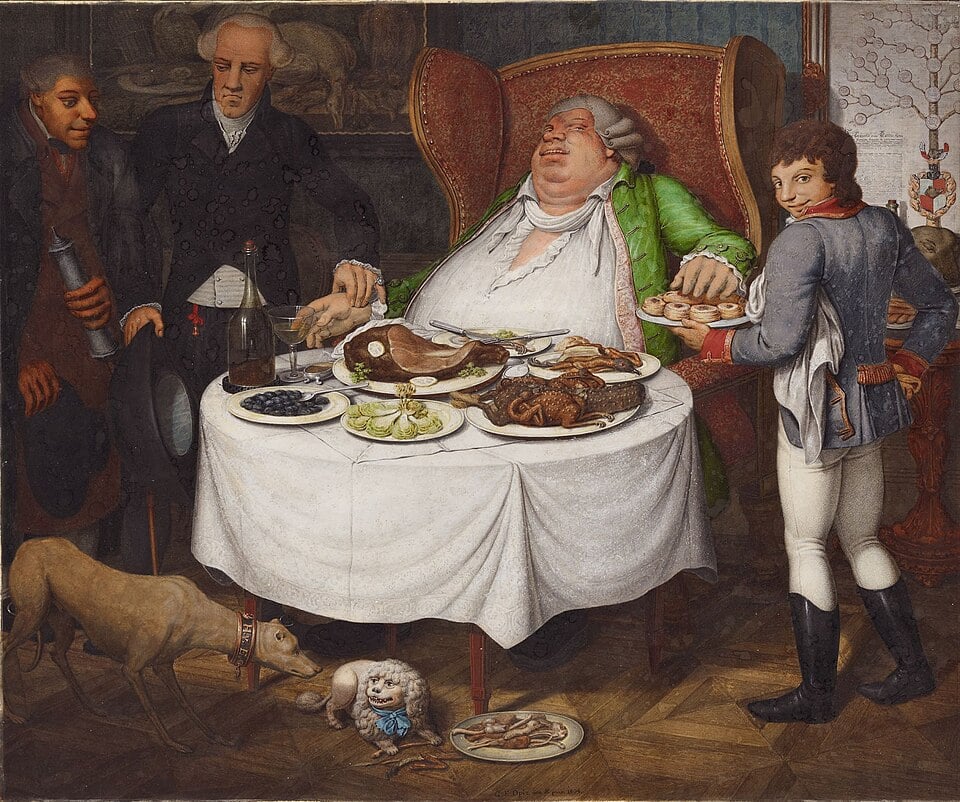By Myron Gananian (August 2025)

Obesity is now recognized as a multifactorial disease, in contrast to my long-held misconception that it was a straightforward discrepancy between caloric intake and expenditure. How naïve. I did not regard it a disease, rather a crime of opportunity; less food, less fat. This prejudice was reinforced by pictures from the beginning of photography in the 1820s. Look at the soldiers in the Civil War, and civilians up to WWII. Clearly, their diet was different. And they were more active. I assume the disease known as obesity did not exist then.
There has been a deluge of techniques suggested to achieve weight loss, so the huge number should imply that few if any, work. Invoking willpower seems fruitless. So do starvation diets and virtually any other kind of dietary restriction or manipulation of contents such as fat, protein, and carbohydrates. Is it possible that the environment and physical mechanics of eating might help to control intake to some significant degree?
Without delving further into the obesity epidemic, let’s consider a now widespread confluence of factors that make it so difficult to consume food in a manner that does not exceed our needs.
What makes us swallow? Post-nasal discharge, foreign body, tongue depressor, saliva, dental manipulation, and Ah Hah, food. If, somehow we could control the frequency with which we swallow each bite, that may help a bit, and in some cases, a lot. Slowing down eating allows the sensation of satiety enough time to kick in and tell us, “Enough.” This requires 20 or more minutes.
Swallowing food is not any different than swallowing saliva. However, there are several factors that increase the rapidity and frequency of our food swallowing, overwhelming our hunger or appetite. The dominant one is so obvious that it has escaped awareness. It is the profound, controlling influence of the next, pending bite of food in relation to the prior bite still in the mouth. The proof of this is easily shown. Place a piece of food in your mouth, chew it as usual, and while you are still doing so, load the utensil and place it in or even near your mouth before you have swallowed the previous morsel. You will find it nearly impossible to prevent your throat from swallowing the portion already in your mouth. You may even find that the sight of the simple act of loading the utensil or the approach of the next bite toward your mouth is sufficient to cause your throat to irresistibly swallow the food already in your mouth. Therefore, how can it be concluded that the following morsel did not cause, even force, you to swallow the previous one, before the time you would have done so had you not placed the second one in or near your mouth? The proximity of the next, about to be eaten, morsel, to either our vision or lips, is what sets off the reflex-like, uncontrollable, swallowing of whatever is in the back of our mouth. The countermeasure? Simple, but difficult. Release the utensil after every bite, resting it in the dish, and do not load it with food until that which is in your mouth is well down the gullet. Folks who are thin should not try this, for it is unlikely to work as described, having solved the problem on their own.
Now, specifically on to fast food, for which all the above is particularly significant. The majority of fast food is handheld, partially due to its foreign origin, but especially to its size, like a cumbersome double cheeseburger. It is not put down between bites, in part since it disintegrates. To maintain its integrity it has to be held until finished. Wraps, tacos, burritos, pizza, hamburgers, gyros, quesadillas, pitas, skewered food, wings, and the winner, hands down, the sandwich. How about the Ruben? These are usually held in the hand until finished. It is very difficult to take a small bite or to nibble on a burrito. Its very size and bulkiness encourage large bites every time. The larger the food item, the larger the mouth opening needs to be to accommodate it. Just watch TV ads for massive hamburgers being eaten with the sauces dripping down their chins. The common consequence of these types of food is that they are not amenable to being put down. They are difficult to put down. They do not lend themselves to being put down and picked up with every bite. So, being handheld until finished, they are at the ready, inches from the lips, egging the portion already in the mouth to get out of the way and make room for the yet uneaten bit so eager to get into that maw which has little self-control. There is a momentum to eating in this manner, a force that we seem not to dominate. A chicken pot pie would be difficult to eat in the manner of a massive hamburger.
The adverse consequences of rapid eating may not be limited to being overweight. There seems to be a rising rate of GERD, in which the normal stomach acid rises into the esophagus, where it does not belong. Globally, GERD rates are increasing, most notably in the young, who favor fast foods. At this very moment, as I write these words, the AP reports about the choking deaths of the elderly. Over 4,000 a year in the over-65 age group, for all the reasons here discussed, in addition to throat muscle changes, dentures, diminished saliva, and the posture of old age, in which even the arthritis of the neck bones can compromise the space of the throat. And possibly the most dangerous, talking. The elderly need to decelerate the rate of eating most of all.
What really is multi-factorial is the move to eating away from home. 40% of American meals take place outside the home, accounting for 60% of food expenditures. What is it about eating out that contributes to the obesity epidemic?
In no order of priority: The death knell of an eating establishment is the notoriety that it provides small portions. The larger the amount served, the greater the popularity. Second, try to find a quiet place to eat, from a hamburger joint to the most expensive. If it is not only the ambient crowd noise, it is the obligatory music. The use of music, fast-paced and intentionally loud, is a studied effort based on proven psychological evidence that shows that it contributes to faster eating, thereby more rapid turnover of customers, and even clouds judgment in choosing food. My wife and I were obliged to leave a California Pizza Kitchen restaurant because the manager was not permitted to turn down the level of music dictated by Corporate. The intentional architectural aspects of hard flooring and the lack of noise-dampening equipment enhance the noise. The popular “Open Kitchen” is a major source of unwanted clatter. With the number of children attracted to fast food establishments, the noise level there is likely to exceed that of the kitchen in a home.
A third factor is that lunchtime for many employed is limited, so that if it involves leaving work for a dining location, time allocated for eating is reduced.
Instead of invoking willpower, it may be more effective to manipulate our eating technique and environment. No distractions, such as reading, watching TV, disturbing conversations, and possibly the worst, talking. Since introspection is a quality difficult to acquire, watching others eat may convince us of our own behavior.
Table of Contents
Myron Gananian is a retired physician living in California.
Follow NER on Twitter @NERIconoclast








3 Responses
Who can resist an article with the title, “The Challenge of Eating Fast Food Slowly”? I thought some of your insights and perceptions were quite interesting. And I’ve also held the belief that some foods, which you mentioned, are very difficult to eat slowly. One must stop completely and begin again. This is cumbersome. Also, eating out is certainly one of the leading causes of poor dietary habits. Home-made and home-eaten meals are considered meals.
I believe that the frenetic pace of living results in a fast meal with minimal swallowing and overeating. Our grandsons inhale their meal with large bites and then are on to the next event. Family custom is also a big factor. Enjoyed the article KG Campbell
Dear Nelson and Campbell: You need to know the inspiration of the article you enjoyed. If it was good writing it is likely to be autobiographical, as this one was. I ate fast, in a hurry, and upset, resulting in an overcooked egg to sit in my totally obstructed esophagus for NINE hours. That is a good inspiration for me to behave henceforth. Thanks for reading, Myron